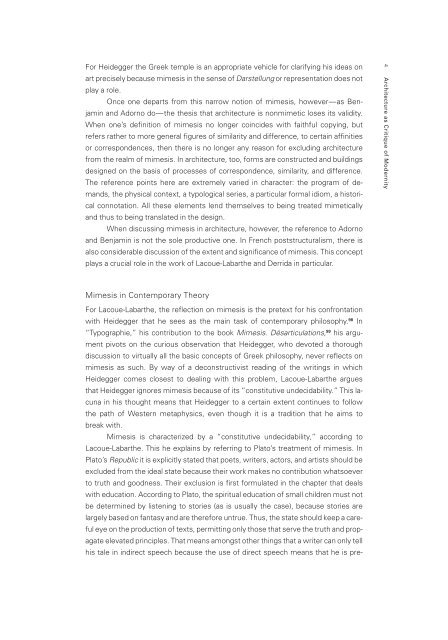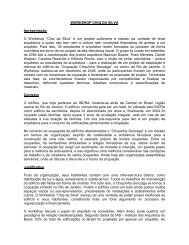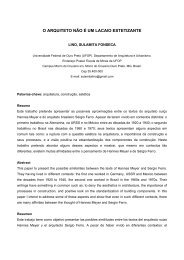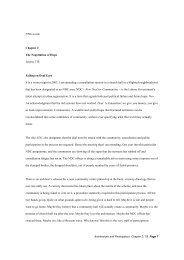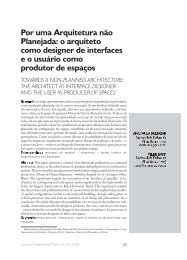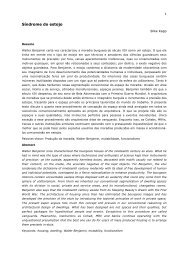Architecture and Modernity : A Critique
Architecture and Modernity : A Critique
Architecture and Modernity : A Critique
Create successful ePaper yourself
Turn your PDF publications into a flip-book with our unique Google optimized e-Paper software.
For Heidegger the Greek temple is an appropriate vehicle for clarifying his ideas on<br />
art precisely because mimesis in the sense of Darstellung or representation does not<br />
play a role.<br />
Once one departs from this narrow notion of mimesis, however—as Benjamin<br />
<strong>and</strong> Adorno do—the thesis that architecture is nonmimetic loses its validity.<br />
When one’s definition of mimesis no longer coincides with faithful copying, but<br />
refers rather to more general figures of similarity <strong>and</strong> difference, to certain affinities<br />
or correspondences, then there is no longer any reason for excluding architecture<br />
from the realm of mimesis. In architecture, too, forms are constructed <strong>and</strong> buildings<br />
designed on the basis of processes of correspondence, similarity, <strong>and</strong> difference.<br />
The reference points here are extremely varied in character: the program of dem<strong>and</strong>s,<br />
the physical context, a typological series, a particular formal idiom, a historical<br />
connotation. All these elements lend themselves to being treated mimetically<br />
<strong>and</strong> thus to being translated in the design.<br />
When discussing mimesis in architecture, however, the reference to Adorno<br />
<strong>and</strong> Benjamin is not the sole productive one. In French poststructuralism, there is<br />
also considerable discussion of the extent <strong>and</strong> significance of mimesis. This concept<br />
plays a crucial role in the work of Lacoue-Labarthe <strong>and</strong> Derrida in particular.<br />
Mimesis in Contemporary Theory<br />
For Lacoue-Labarthe, the reflection on mimesis is the pretext for his confrontation<br />
with Heidegger that he sees as the main task of contemporary philosophy. 98 In<br />
“Typographie,” his contribution to the book Mimesis. Désarticulations, 99 his argument<br />
pivots on the curious observation that Heidegger, who devoted a thorough<br />
discussion to virtually all the basic concepts of Greek philosophy, never reflects on<br />
mimesis as such. By way of a deconstructivist reading of the writings in which<br />
Heidegger comes closest to dealing with this problem, Lacoue-Labarthe argues<br />
that Heidegger ignores mimesis because of its “constitutive undecidability.” This lacuna<br />
in his thought means that Heidegger to a certain extent continues to follow<br />
the path of Western metaphysics, even though it is a tradition that he aims to<br />
break with.<br />
Mimesis is characterized by a “constitutive undecidability,” according to<br />
Lacoue-Labarthe. This he explains by referring to Plato’s treatment of mimesis. In<br />
Plato’s Republic it is explicitly stated that poets, writers, actors, <strong>and</strong> artists should be<br />
excluded from the ideal state because their work makes no contribution whatsoever<br />
to truth <strong>and</strong> goodness. Their exclusion is first formulated in the chapter that deals<br />
with education. According to Plato, the spiritual education of small children must not<br />
be determined by listening to stories (as is usually the case), because stories are<br />
largely based on fantasy <strong>and</strong> are therefore untrue. Thus, the state should keep a careful<br />
eye on the production of texts, permitting only those that serve the truth <strong>and</strong> propagate<br />
elevated principles. That means amongst other things that a writer can only tell<br />
his tale in indirect speech because the use of direct speech means that he is pre-<br />
4 <strong>Architecture</strong> as <strong>Critique</strong> of <strong>Modernity</strong>


